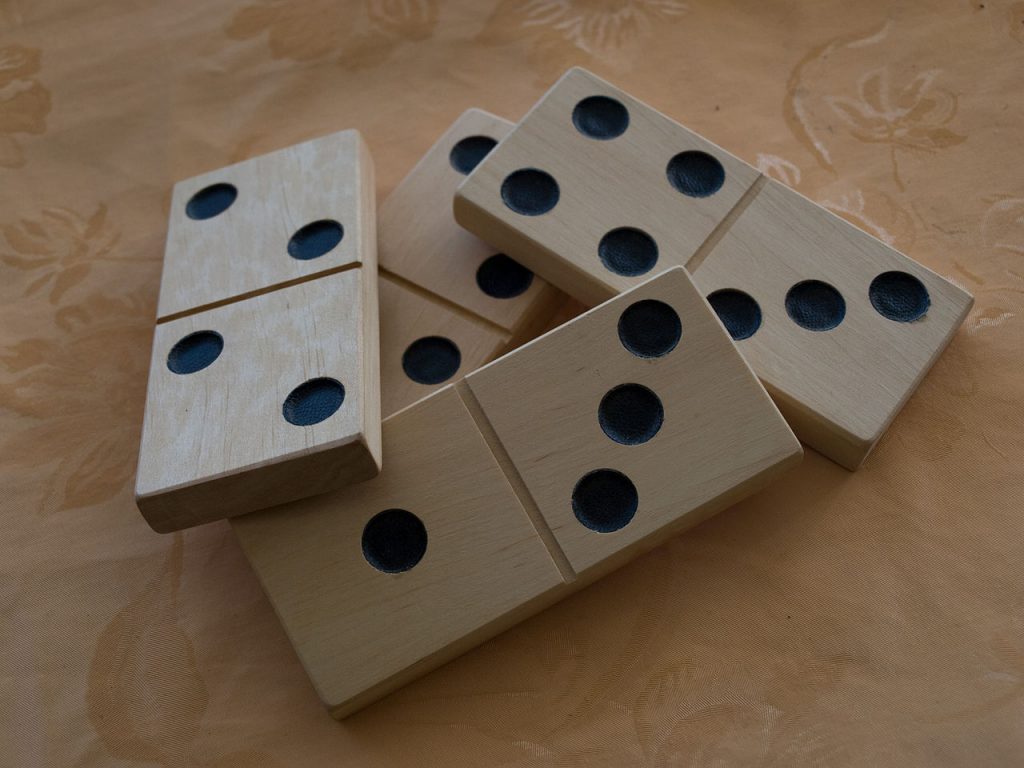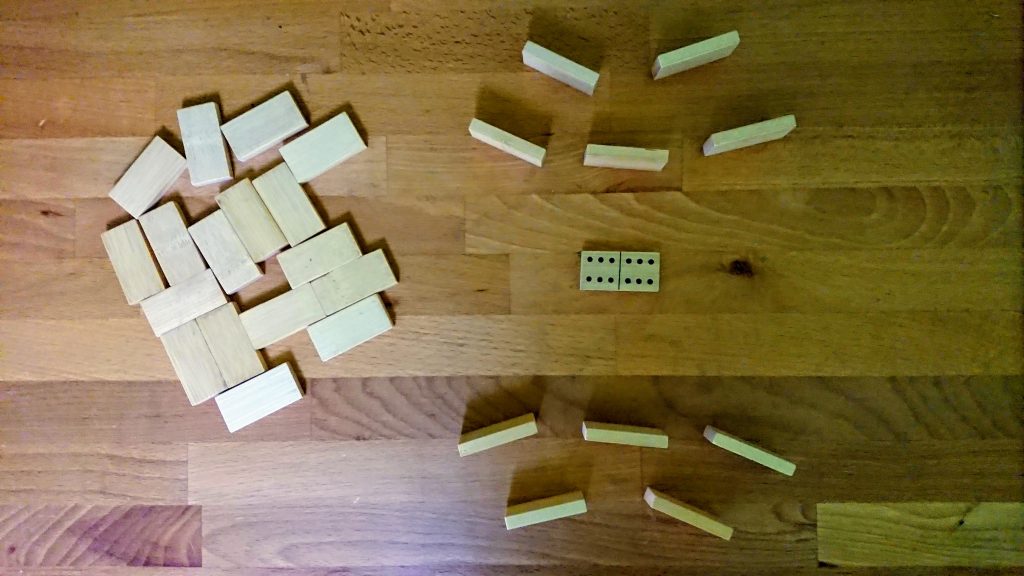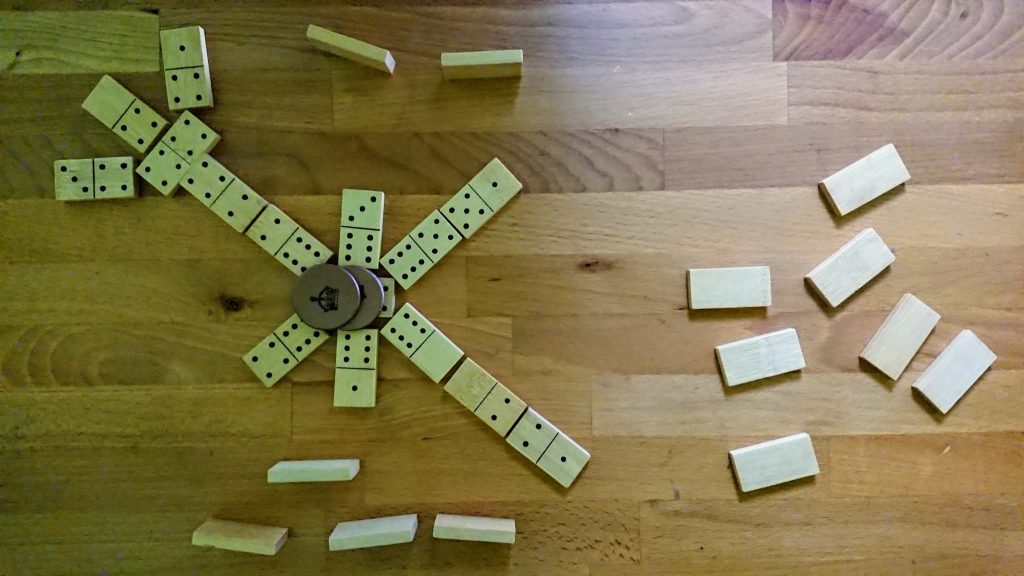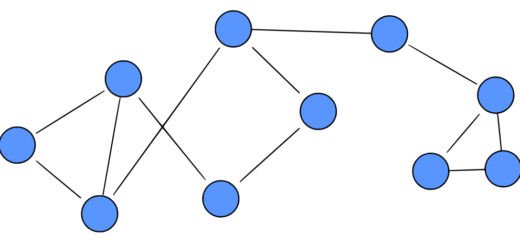Mineshaft, Domino Game for Altera Awaken LARP
I play a local LARP (Live Action Roleplaying Game) called Altera Awakens. One of the most enjoyable aspects of LARPs, is the opportunity to create, explore and collectively contribute to artificial cultures and histories. The one I’m involved with is called Moragon… a mostly subterranean nation, isolated culture of miners, artisans and workman. It is a place of hard work, harsh conditions and practical, serious people. However, they do occasionally get to partake in a bit of fun.

The following is a game is closely based on the domino game “block family” of Cyprus/Sebastopol; this is an adaptation not an original creation and there are many variations. It can be played with either a double-six, double-nine set of dominoes or even double-twelve set, with larger sets allowing for more players. I’ll be using a double-six set since I have lots of those laying around from playing another LARP, Dust to Dust*.
Step 1: Set Up
A full set of dominoes is shared among all the players (recommended 2-4 if you are using double-six dominoes). In the first round, the double-six is pulled out and set aside. This will form the initial “mineshaft”.
Each player draws a “hand” of 5 dominoes from a face down, shuffled pile of dominoes without looking at them. Some enthusiasts do this politely, one domino at a time, going around the circle of players; while others prefer a mad scrabble for their “lucky” tiles.

Do NOT reveal your hand to other players!
All remaining dominoes remain face down and are set aside within reach in a “rubble pile”.
Optional: All players put an “ante” into the pot (typically placed on top of the current mineshaft domino). A single copper coin each is typical, but sometimes Moragoni will use something else of value (ore, gem, tool, potato, etc), as long as it something everyone mutually agrees beforehand.
Step 2: Opening Round
Set the double-six in a central location on the table, accessible to all players. Players draw and show a tile from the rubble pile, with the highest pip value going first and play proceeding clockwise around the table from her for the rest of the game. Reshuffle these tiles back into the rubble pile.
Player One must connect a tile bearing six pips on one end to the starting-double six “mine-shaft”.
At any time during play, if a player does not have a tile with pips to match any open tiles in the the pattern currently on the board, she must draw a tile randomly from the rubble pile. If this tile still does not match, this tile goes into her hand and the round progresses clockwise to the next player. Matching tiles MUST be played. A player may not elect to not play a matching tile.
This process of playing off the initial double-six mine shaft continues until six “shafts” are “dug” (filled with a matching tiles). At that point, any players may play tiles off the end of any of the six shafts on their turn, and no new shafts may be played on the initial double-six.

From this point forward, players may play tiles on any of the six open shafts but these shafts do not “branch” unless a double is played on them. This is called “striking a vein”. When this happens the double-tile is played perpendicular the shaft it is played on. From the moment a vein is struck, it must be “explored” before players can play tiles on the other shafts.

Once three matching tiles have been played on the new vein, all shafts on the board are open to played on again. This process repeats every time a new vein is “struck” with a double tile on any shaft.
Step 3: End Game
The game concludes when any player plays her last tile OR when the rubble pile is empty and no player can play a tile from their hand. In the case for the former, the player with an empty hand wins. In the case of the later, the player with the lowest “pip” value on the tiles remaining in their hand wins.
Optional: If playing for an ante or wager, the winner collects it now.
Step 4: Variations
For longer games, remaining pips after the game described above are tallied and recorded. Then second and subsequent rounds are played in exactly the same way, using the next lower double-pip tile until the double-blank is reached. At that point, the pot/haul is collected by the person with the lowest total tally from all rounds combined.








